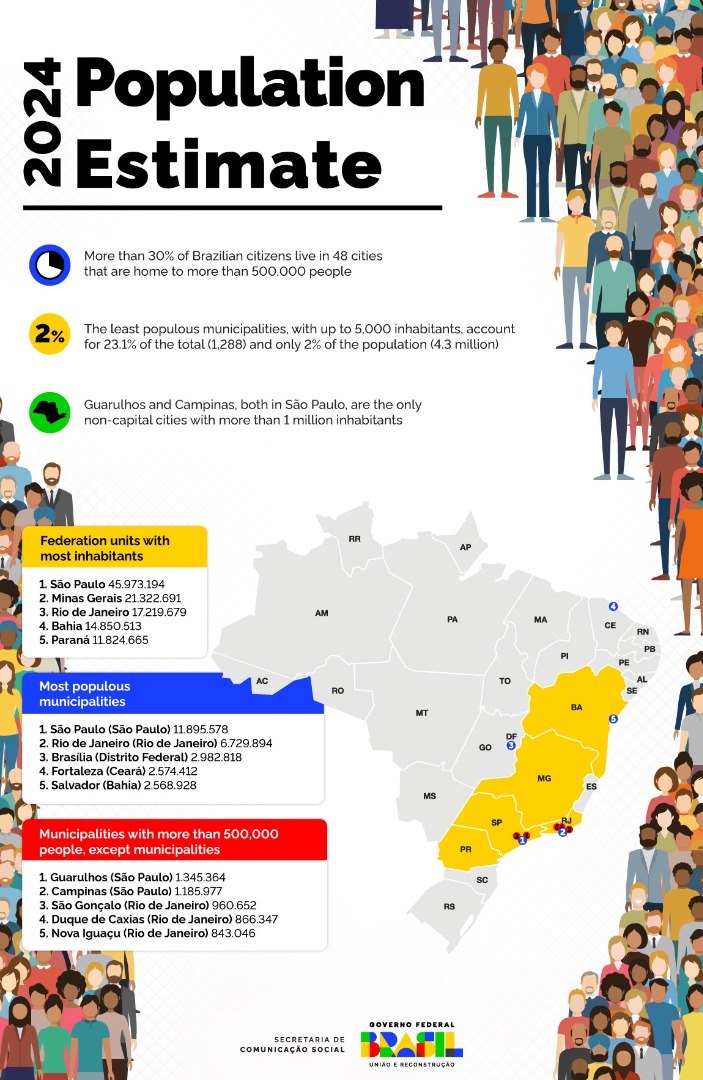Notícias
RESEARCH
IBGE: Brazil's population reaches 212.6 million

São Paulo is Brazil’s most populous city, with 11.9 million inhabitants - Credit: Paulo Pinto/Agência Brasil
The Brazilian population reached an estimated 212.6 million people on July 1, 2024, according to the Brazilian Institute of Geography and Statistics (IBGE) [Instituto Brasileiro de Geografia e Estatística/IBGE]. The survey data was published on the Official Gazette of the Union on Thursday, August 29, by means of an ordinance.
The IBGE study is one of the parameters used by the Federal Court of Auditors [Tribunal de Contas da União/TCU] to calculate the State and Federal District Participation Funds [Fundos de Participação dos Estados e do Distrito Federal/FPE] and the Municipal Participation Funds [Fundos de Participação dos Estados e do Distrito Federal dos Municípios/FPM), which is a constitutional instrument for transferring funds from the Union to states and municipalities provided. The survey is also a reference for social, economic and demographic indicators.
CITIES — According to the survey, the country has 15 cities with over 1 million inhabitants; 13 are capitals. In total, 42.7 million people live in these cities, representing 20.1% of the country’s population. São Paulo continues to be the most populous Brazilian city, with 11.9 million inhabitants, followed by Rio de Janeiro (6.7 million), Brasília (3 million), Fortaleza (2.6 million) and Salvador (2.6 million).
Guarulhos and Campinas, both in São Paulo, are the only non-capitals to appear on the list, with 1.3 million and 1.2 million, respectively. They are also the most populous of the 26 municipalities with more than 500,000 inhabitants that are not capital cities. São Gonçalo (RJ) is third, with 961 thousand.
At the bottom of the list, 26 municipalities have fewer than 1,500 inhabitants. Serra da Saudade (MG) is the least populous, with 854. Anhanguera (GO) and Borá (SP), with 921 and 928, complete the list of towns with less than a thousand inhabitants.

- INFOGRAPHIC | The survey data was published in the Thursday, August 29 edition of the Federal Official Gazette
FEDERATION UNITS — Among the Federation Units [Unidades da Federação/UF], São Paulo harbors 21.6% of the population, with 46 million people. Minas Gerais, with 10% (21.3 million) and Rio de Janeiro, with 8.1% (17.2 million), close the list of the three states with most inhabitants. At the other end, five UFs harbor less than 1% of the country's population: Rondônia (0.8%), Tocantins (0.7%), Acre (0.4%), Amapá (0.4%) and Roraima (0.3%).
REGIONS — When looking at the population of Metropolitan Regions, Integrated Development Regions and Urban Agglomerations, the list has 30 with more than 1 million inhabitants, adding up to more than 100 million people. São Paulo leads with 21.5 million, followed by Rio de Janeiro (12.9 million), Belo Horizonte (6 million), the Federal District and Surroundings (4.7 million), Fortaleza (4.2 million) and Porto Alegre (4.1 million).
“Although the largest urban centers no longer show the great growth of the past, they still have the demographic weight that comes from a process of concentration that lasted for several decades — and, over the years, several municipalities ended up surpassing the 500 thousand inhabitants mark” – Marcio Minamiguchi, Manager of Population Projections and Estimates at IBGE
CONCENTRATION — The survey also revealed the distribution of the Brazilian population and municipalities according to the classes of population size. Altogether, 65.7 million people, or 30.9% of the total, are distributed across 48 municipalities with a population greater than 500,000 people, or 0.9% of Brazilian municipalities. Another considerable portion of the population, around 27.3% (58 million), is in the 339 municipalities with a population between 100,000 and 500,000, which corresponds to 6.1% of the total number of municipalities.
“Although the largest urban centers are no longer experiencing the great growth they once did, they still have the demographic weight that comes from a process of concentration that lasted for several decades — and, over the years, several municipalities have ended up surpassing the 500,000 inhabitants mark,” explained Marcio Minamiguchi, the manager of Population Projections and Estimates at IBGE.
At the other end, the least populated municipalities, with up to 5 thousand inhabitants, are 23.1% of the total (1,288) and account for only 2% of the population (4.3 million).
METHOD — The estimates of the resident population in the municipalities were calculated based on the Population Projections for Brazil and Federation Units, 2024 Revision [Projeções da População do Brasil e Unidades da Federação, Revisão 2024] and on the total population of the municipalities listed by the 2010 and 2022 Demographic Censuses.